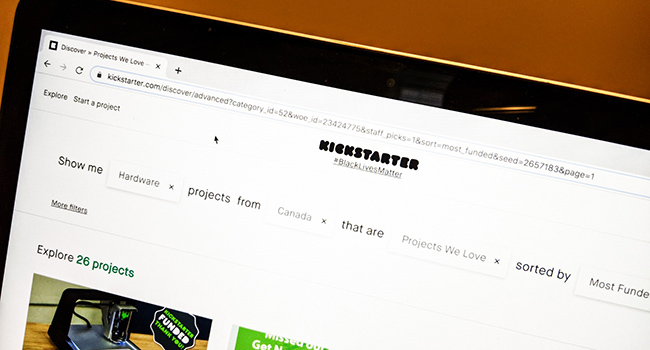“There is this sense that past entrepreneurial successes somehow have a spillover effect, a tide that lifts all boats and helps future entrepreneurs, but that has been very difficult to test,” said University of Alberta entrepreneurship researcher Joel Gehman, who supervised the study conducted by Jean-François Soublière as part of his PhD dissertation.
Thanks to the crowdfunding platform Kickstarter, Soublière and Gehman were able to test with very fine precision ideas about how past successes and failures shaped future endeavours, as well as their likelihood of success or failure.
Kickstarter allows people with an idea or a product to launch fundraising campaigns that look for backers to pledge small amounts of money. Project creators choose a deadline and a minimum funding goal, and only collect if that goal is met.
Unlike investors, crowdfunding contributors don’t have a stake in the business. In exchange for their contributions, backers receive a variety of rewards, such as a copy of the work being produced or one-of-a-kind experiences. About 30 per cent of Kickstarter backers pledge money to more than one endeavour, with an average pledge of $80.
Soublière got the idea for the study after following the first major blockbuster campaign on Kickstarter, for a video game called Double Fine Adventure.
“The campaign asked for $400,000, which was a huge amount back in 2012, and ended up raising millions,” he said. “Many other blockbusters happened shortly afterwards.”
“People were wondering if these big successes were stealing backers from little creators, but the opposite actually happened. This prompted me to look at the role of prior successes and failures on subsequent campaigns.”
Soublière and Gehman sifted through 182,000 Kickstarter campaigns across the platform’s 165 categories, which range from restaurants to board games.
The pair then analyzed the effect the different levels of success have on subsequent campaigns.
From the data, the team created four outcomes: broken path failures, which are campaigns that never get above 20 per cent of the goal; path-breaking failures, which are those efforts that fall just short of their goal; unsung successes, which are campaigns that achieve their monetary goals but little to no more; and blockbuster successes, which are campaigns that get 150 per cent or more of what they wanted.
The study shows the best thing you could do is follow into a category with blockbuster successes.
“If category X had lots of blockbuster successes, the campaigns that come along after those, all else being equal, are more likely to succeed because they’re in a place where there’s a lot of enthusiasm and interest for what’s going on,” said Gehman.
And while logic dictates the next best category would be unsung successes, the study showed the second best place to be is in a category where there are a number of path-breaking failures.
Counterintuitively, moderate success doesn’t breed more success. As an example, the paper compared this effect to the wave of mobile applications that followed the rise of smartphones, which resulted in “app fatigue” among investors as the market became flooded.
Meanwhile, campaigns that failed by nearly missing their goals are beneficial. “It seems backers who pledge their support to a campaign that ultimately fails are bummed by the outcome and want to try again,” said Soublière.
Gehman uses an example of a board game that excites a segment of enthusiasts but for one reason or another comes up short of its fundraising goal. This installed base of backers begins to accumulate as the path-breaking failures mount.
“The fact that the game came so close may inspire backers to pledge their support to other campaigns,” said Gehman. “Waiting there is this ready base of backers that the next set of entrepreneurs can draw on, a community that’s already been built.”
“People compete in markets, but markets are also a community of people,” said Soublière. “Whether entrepreneurs succeed or fail, all have a role to play in furthering this community.”
| By Michael Brown
This article was submitted by the University of Alberta’s online publication Folio, a Troy Media content provider partner.
The views, opinions and positions expressed by columnists and contributors are the author’s alone. They do not inherently or expressly reflect the views, opinions and/or positions of our publication.



